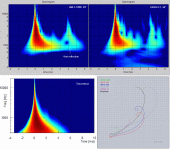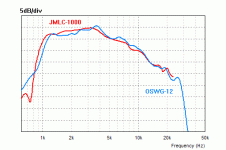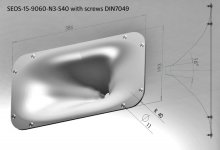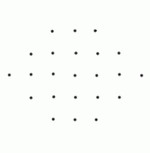I face a bit of group delay due to my waveguide's centre distance. At one point my drivers are over 90 degrees out of phase and I suffer a moderate on axis dip just below 1kHz.
To what point can I safely ignore the dip and just aim for the right power response in that region?
To what point can I safely ignore the dip and just aim for the right power response in that region?
Just to be clear, I did, but I found that there was no value in it for me. I believe that this is why there aren't any on the market right now. It seems like a simple part, and maybe it is if you have a lot of money for tooling, etc. but in small lots its very expensive and people just don't want to pay a price that is interesting to a manufacturer.
Some time ago there was a long thread about making waveguides. The overwhelming postion at that time was that they would be easy to make and that I was just gouging the market. OK, where are they then? That thread was the reason that I stopped selling them. Simply put the waveguide, foam plug and mounting plate are the key to what I make and sell and represent the greatest value-added by far. I am not willing to give this away without due compensation for this value added.
I don't make stand alone waveguides, they are molded into a custom baffle. It is extra work for me to cut them out. I have, and will, sell the baffles with foam plug and mounting plate. Just contact me on the side because I do not advertise this. But be fore warned, they are not cheap.
I probably shaved a couple years off my life breathing all the chemicals, and nearly chopped off my right thumb too. But I've made a pile of waveguides, and I posted the instructions on how to build your own over on htguide. I'm too lazy to google it, but the instructions are over there if anyone wants to build their own.
Having said that, I value my time (and my fingers) and I just bought a pair of Summas after screwing around with the DIY route for a while.
Doug, you're sure acting strangely here lately, seeming to want to pin things down into absolutes. No absolutes exist in audio, (or in most things). The geddes compromises are different from those of "Econowave" and each will have their proponents. I'm surprised none of the other Ewavers have tried my foam solution- there's obvious ripple at cutoff with that horn and it's well controlled with my foam without expanding CTC...
Check out my "homster" thread on here. My experience with treating the mouth of a horn was a real revelation. I spent the better part of a decade obsessing over the geometry of the curve, without ever realizing that the termination of the throat and the mouth is hugely important.
Good to see you're seeing improvements in the measurements, and hearing improvements in the room.
This stuff works!
I probably shaved a couple years off my life breathing all the chemicals, and nearly chopped off my right thumb too. But I've made a pile of waveguides, and I posted the instructions on how to build your own over on htguide. I'm too lazy to google it, but the instructions are over there if anyone wants to build their own.
Having said that, I value my time (and my fingers) and I just bought a pair of Summas after screwing around with the DIY route for a while.
We can source 12" OSWG for around $100 now next solution is going to be a 15" SEOS. I have always disagreed that it can not be done.
Geddes won't be the only OS waveguide choice any more.
A question about the 18sound XT1086. Early reports were that it was a diffraction horn but it looks somewhat like an OS. Is this true?
Has anyone used it down below 1kHz with any success?
Living across the pond, there hasn't been an ideal option that I've been aware of. What product are you talking about?
Has anyone used it down below 1kHz with any success?
We can source 12" OSWG for around $100 now next solution is going to be a 15" SEOS. I have always disagreed that it can not be done.
Geddes won't be the only OS waveguide choice any more.
Living across the pond, there hasn't been an ideal option that I've been aware of. What product are you talking about?
Living across the pond, there hasn't been an ideal option that I've been aware of. What product are you talking about?
There has been a group buy waveguide thread for a long time. They have started shipping what was being offered, one was the 12" OSWG. Across the pond should be a good thing for shipping costs from poland.
There is a new discussion on AVSForum.com looking for a better OS design. The 15-SEOS is being finalized now. We are hoping for manufacturing in the US instead of Poland though since shipping will be cheaper. I see the solution being cheaper then $100 in the end.
A question about the 18sound XT1086. Early reports were that it was a diffraction horn but it looks somewhat like an OS. Is this true?
Has anyone used it down below 1kHz with any success?
You might want to search Zilch's thread on techtalk
Flex Your PCD Mettle: - Techtalk Speaker Building, Audio, Video, and Electronics Customer Discussion Forum From Parts-Express.com
Here is an updated picture of the prototype
Looks like kind of like the popular QSC HPR152i waveguide (Which isnt sold any more, that could change too).
An externally hosted image should be here but it was not working when we last tested it.
Looks like kind of like the popular QSC HPR152i waveguide (Which isnt sold any more, that could change too).
what do you guys think about this peculiar looking horn
Pyle Pro PH715 1" Bolt-On Constant Directivity Horn | Parts-Express.com
apparently the same horn is used in NEXO PS8 speakers
Pyle Pro PH715 1" Bolt-On Constant Directivity Horn | Parts-Express.com
apparently the same horn is used in NEXO PS8 speakers
Now that's SolidWorks if I've ever seen it.Here is an updated picture of the prototype
An externally hosted image should be here but it was not working when we last tested it.
Looks like kind of like the popular QSC HPR152i waveguide (Which isnt sold any more, that could change too).
Is calculating power response something that is beyond the average person?
Say, you have taken half a dozen response plots at varying angles. You now want to average them. Would you average the levels in dB, or convert them to absolute voltages and them average them?
Or would you weight them according to their direction, or perhaps weight them according to their in room environment?
I've looked at some of the formulas and had that sinking feeling.
Say, you have taken half a dozen response plots at varying angles. You now want to average them. Would you average the levels in dB, or convert them to absolute voltages and them average them?
Or would you weight them according to their direction, or perhaps weight them according to their in room environment?
I've looked at some of the formulas and had that sinking feeling.
Is calculating power response something that is beyond the average person?
Not if you are handy with a spreadsheet.
It is power, so you must average pressure squared. You must then weight it by the area of the sphere that each measurement represents.
If you have SPL curves then you can unlog with an equation like 10 raised to the (SPL/20) to get back to pressure. Square that and weight (multiply)times the spherical area that it best represents.
To make the area weighting easy you can figure out an equal area sampling approach, for example, B&K showed that vertical rings of a sphere with equal
height had equal area.
Finally, for the truly lazy, if you look at Toole you will see that the 60 and 75 degree off-axis curves that he averaged came awfully close to the power response of a lot of systems.
David S.
I assume you're not talking about any specific spreadsheet, I'm using a hand calculator to good effect. I'd be happy working on just 1/3 octave samples.Not if you are handy with a spreadsheet.
I have horizontal 0, 10, 20, 30, 40 and 50. I could simply conclude that they cover an equal sector size and weight them equally.You must then weight it by the area of the sphere that each measurement represents.
I could de-log and square as you suggested and then simply average the six, however I wonder whether I should negatively weight the angles that coincide with the side reflection absorbers that I have in my room.
I assume you're not talking about any specific spreadsheet, I'm using a hand calculator to good effect. I'd be happy working on just 1/3 octave samples.
I have horizontal 0, 10, 20, 30, 40 and 50. I could simply conclude that they cover an equal sector size and weight them equally.
I could de-log and square as you suggested and then simply average the six, however I wonder whether I should negatively weight the angles that coincide with the side reflection absorbers that I have in my room.
Horizontal slices of equal angle don't represent equal areas.
First, are your vertical and horizontal responses the same? If not then horizontal curves aren't enough. If the horn is circular and horizontal and vertical are the same, then each measurement represents a ring on the sphere (the 20 degree measurement could be a ring from 15 to 25 degrees encircling the 0 degree axis. You will see that each subsequent ring is a greater area and must have more weighting in the power average. You also have nothing to represent the back side of the sphere.
If you delog, etc. and then area weight you can get to a "frontal hemispheric average" more or less. There is a question of sufficient sampling of the sphere, but you are probably okay if the off axis response is well behaved (no big lobes that your are missing).
Note that weighting with regard to sidewall reflections may be appropriate but you are no longer pursuing a power response.
I was assumming Excel, but any spreadsheet would do, as would a hand calculator if you like repetitious crunching. I assumed you had the response curves as data points that could be imported (a matrix of SPL vs. F).
David S.
I could de-log and square as you suggested and then simply average the six, however I wonder whether I should negatively weight the angles that coincide with the side reflection absorbers that I have in my room.
That will give you a rough estimate (fairly rough actually) if done correctly, such as weighting by the area, etc. but you have to remember that this must be "free field" data. If reflections are present than you are not getting the power response of the source, but of the room. In that case you need to spatially average the data.
Horizontal slices of equal angle don't represent equal areas.
First, are your vertical and horizontal responses the same?
I was tyrying to do the system, which is definately not the same vertically and horizontally. Now, if I were doing the (symmetrical) horn alone, I could simply imagine the circular wavefront and weight according to the height of a vertical chord which intersects the point between the source and the mic...then square it.
For the whole system I guess I could do a quasi thing, like the attached image.
Once I average should I root then convert back to dB?If you delog, etc.
If reflections are present than you are not getting the power response of the source, but of the room. In that case you need to spatially average the data.
I used tape on the floor in front of the speaker, fixed the mic, and rotated the speaker whilst huddling absorbers around to produce a semi anechoic area. I will be ignoring the lower end of the results.
Attachments
Allen, can you gate the measurement? I'm not so sure I like your method. Here's what I do to make gated graphs:
****DanTheMan's blog****: Gating loudspeaker measurements
Your lower end accuracy will be very limited, but you are not after that and I don't think it's very needed.
Good luck,
Dan
****DanTheMan's blog****: Gating loudspeaker measurements
Your lower end accuracy will be very limited, but you are not after that and I don't think it's very needed.
Good luck,
Dan
- Home
- Loudspeakers
- Multi-Way
- Geddes on Waveguides



